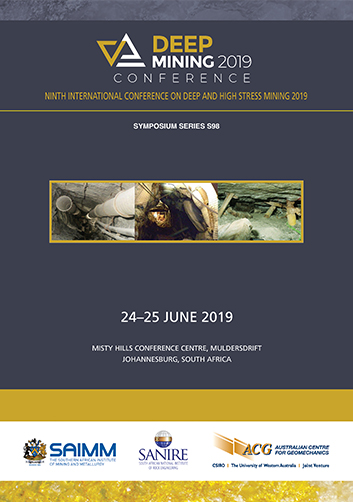Ideal stope profile to manage seismicity in deep tabular narrow reef mines

|
Authors: Rakumakoe, O |
DOI https://doi.org/10.36487/ACG_rep/1952_22_Rakumakoe
Cite As:
Rakumakoe, O 2019, 'Ideal stope profile to manage seismicity in deep tabular narrow reef mines', in W Joughin (ed.), Deep Mining 2019: Proceedings of the Ninth International Conference on Deep and High Stress Mining, The Southern African Institute of Mining and Metallurgy, Johannesburg, pp. 293-306, https://doi.org/10.36487/ACG_rep/1952_22_Rakumakoe
Abstract:
More regional stability pillars have been introduced in deep narrow reef mining stope designs with an aim of increasing the loading area and reducing the induced stress on the active mining stope faces creating a stiffer loading system. Mponeng mine introduced strike pillars into the conventional sequential grid mining layout in 2014 further reduce an already low extraction ratio. This resulted in a reduction in the overall seismic potency two years later, however, the seismic potency/production graphs remained erratic month on month. Cycle mining practice introduced in 2016 was observed to enable compliance to the inter-panel lead-lag standard however did not reduce the erratic seismic response. Studies into the sources of seismic events has indicated that shear fracturing ahead of the stope face is one of the main seismic sources in deep gold mines. In this paper we illustrate that by establishing an ideal stope profile to manage the formation of the shear fractures, a much more consistent seismic potency/production graph can be achieved.
References:
Adams, G. R., Jager, A. J., & Roering, C. (1981). Investigations of rock fractures around deep level gold mine stopes. Proceedings of the 22nd US Symposium on Rock Mechanics, (pp. 227-236). Cambridge, Massachusetts: American Rock Mechanics Association.
Applegate, J. D. (1991). Rock Mechanics Aspects of Sequential Grid Mining. Johannesburg: University of the Witwatersrand.
Goldbach, O. D., Rangasamy, T., Linzer, L. M., Kataka, ,. M., Spottiswoode, S. M., & du Pisani, P. (2006). Lead-lag design criteria and seismicity patterns. Johannesburg: SIMREC.
Jager, A. J., & Ryder, J. A. (1999). A hand book on rock engineering practice for tabular hard rock mines. Johannesburg: SIMRAC.
McGarr, A. (1971). Violent Deformation of Rock Near Deep-Level, Tabular Excavations - Seismic Events. Bulletin of the Seismological Society of America, 1453 - 1466.
McGarr, A., Pollard, D., Gay, N. C., & Ortlepp, W. D. (1979). Observations and analysis of structures in exhumed mine-induced faults. Observations and analysis of structures in exhumed mine-induced faults. 79-1239, 101 - 120.
Ryder, J. A., & Jager, A. J. (2002). A Textbook on Rock Mechanics for Tabular Hard Rock Mines. Johannesburg: The Safety in Mines Research Advisory Committee (SIMRAC).
Scheepeers, L. J., Hofmann, G., & Morkel, I. G. (2012). The Study of Seismic Response to Production for a Grid Mining Layout. Southern Hemisphere International Rock Mechanics Symposium. Sun City: SAIMM.
Van Aswegen, G. (2013). Forensic rock mechanics, Ortlepp shears and other mining induced structures. Eight international symposium on Rockburst and Seismicity in Mines, Volume 1, (pp. 1-19). Saint-Petersburg.
van Aswegen, G., & Stander, M. (2012). Origins of some fractures around tabular stopes in deep South African mines. The Journal of The Southern African Institute of Mining and Metallurgy, 729 - 735.
© Copyright 2025, Australian Centre for Geomechanics (ACG), The University of Western Australia. All rights reserved.
View copyright/legal information
Please direct any queries or error reports to repository-acg@uwa.edu.au
View copyright/legal information
Please direct any queries or error reports to repository-acg@uwa.edu.au